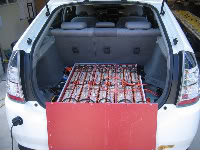Electric Vehicles and Lithium Shortages

The true eco-friendliness of EVs is a frequently debated topic here — largely built around potential shortages of lithium carbonate, the mineral from which lithium-ion batteries are made. Frequent blogger and thoughtful guy Edgar M. van Wngerden writes:
Here: http://www.theoildrum.com/node/6228 is the estimated outcome of an EV rampup based on the analysis of Jack Lifton: a fivefold increase in battery cost due to use of LOWER GRADE Lithium-carbonate ores (a $50.000 battery lasting 10 years, instead of a $10.000 battery at present -no recycling possible). And this would have to include Bolivia. I personally do not think the rainbow coalition in Bolivia would go along with this mining scheme, as it comes with great environmental destruction.
Of course you can find reports by lithium miners and their paid consultants… I highly regard Jack as simply the best in his field, and of the highest integrity. A true independent.
Thanks for this, Edgar; it will be interesting to see how this plays out. And you’re most certainly correct that one can find reports defending practically any position one wants to take here.
I’m reminded of a talk I had on this subject with the CEO of (battery supplier) Ener1, Charles Gassenheimer. When I asked him about an impending lithium shortage, he told me, “We didn’ t think there was oil there either — until we started to look for it. And within a few years, we found it in great abundance. Unfortunately, we burned it all up.”
Again, thanks for weighing in.


The Lifton analysis is very weak, missing and mis interpreting many variables. Here is a very useful document by the Electrification Coalition (includes Nissan, A123 etc).
http://www.electrificationcoalition.org/535928473533888957466293/EC-Road… (very large – but good information on many things EV)
There is a full sub-chapter devoted to Lithium Batteries. Li batteries contain very small amounts of Lithium – something like 1%. 100% of it is recyclable.
The Argonne analysis estimates bullish U.S. and global growth curves for electric vehicle Penetration with four possible lithium-ion battery chemistries. The researchers found that in 2030, vehicles would require about 28,000 tons of net incremental lithium production, approximately equal to total production today. The need for new material rises until around 2035, at which point it begins to fall as sufficient recycled supplies account for a large fraction of new demand.
US production stopped as the mining company found Chile to be cheaper. Chile provides 50% of current production and Bolivia with the largest known reserves doesn’t produce any lithium.
In 2000, as a result of expansion of lithium carbonate production
from Chilean brines (and the development of Argentine brine resources), lithium prices fell
to around $2,000 per ton, where they remained for the first half of the decade. U.S. mines in
North Carolina were closed, and Australia’s production became restricted to use in ceramic
and glass production. Chilean production expanded rapidly. Today, the Salar de Atacama in
Chile holds at least 20 percent of the world’s known reserves and supplies nearly 50 percent
of global lithium demand.